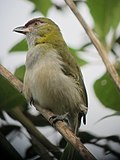Superregnum: Eukaryota
Regnum: Animalia
Subregnum: Eumetazoa
Cladus: Bilateria
Cladus: Nephrozoa
Superphylum: Deuterostomia
Phylum: Chordata
Cladus: Craniata
Subphylum: Vertebrata
Infraphylum: Gnathostomata
Superclassis: Tetrapoda
Cladus: Reptiliomorpha
Cladus: Amniota
Classis: Reptilia
Cladus: Eureptilia
Cladus: Romeriida
Subclassis: Diapsida
Cladus: Sauria
Infraclassis: Archosauromorpha
Cladus: Crurotarsi
Divisio: Archosauria
Subsectio: Ornithodira
Subtaxon: Dinosauromorpha
Cladus: Dinosauria
Ordo: Saurischia
Cladus: Theropoda
Cladus: Neotheropoda
Infraclassis: Aves
Ordo: Passeriformes
Subordo: Passeri
Parvordo: Corvida
Superfamilia: Corvoidea
Familia: Vireonidae
Genus: Cyclarhis
Species: C. gujanensis – C. nigrirostris
Name
Cyclarhis Swainson, 1824
Typus
Tanagra gujanensis Gmelin, 1789 = Cyclarhis gujanensis
References
Swainson, W.J., 1824. An Inquiry into the Natural Affinites of the Lanidae, or Shrikes; preceded by some Observations on the present state of Ornithology in this Country. Zoological Journal Vol.1:289-307. From March, 1824, to January, 1825. London. BHL Reference page. Original description p.294 BHL
The peppershrikes are two species of passerine bird found in tropical Central and South America. They form the genus Cyclarhis, part of the vireo family.
These are heavyset birds with a hooked shrike-like bill. Although sluggish and very vocal, the peppershrikes are still difficult to spot as they feed on insects and spiders in the canopy aloft. Their cup-shaped nests can likewise be found high in the trees.
Taxonomy
The genus Cyclarhis was introduced in 1789 by the English naturalist William Swainson to accommodate a single species, the rufous-browed peppershrike, which is therefore the type species.[1][2] The genus name is from the Ancient Greek kuklos meaning "circle" and rhis, rhinos meaning "nostrils".[3] The genus contains two species.[4]
Species
| Image | Common Name | Scientific name | Distribution |
|---|---|---|---|
 |
Rufous-browed peppershrike | C. gujanensis | Mexico and Trinidad south to Argentina and Uruguay. |
 |
Black-billed peppershrike | C. nigrirostris | Colombia and northern Ecuador. |
References
Swainson, William John (1824–1825). "An inquiry into the natural affinities of the Laniadae, or shrikes; preceded by some observations on the present state of ornithology in this country". Zoological Journal. 1 (3): 289–307 [294].
Paynter, Raymond A. Jr, ed. (1968). Check-List of Birds of the World. Vol. 14. Cambridge, Massachusetts: Museum of Comparative Zoology. p. 103.
Jobling, James A. (2010). The Helm Dictionary of Scientific Bird Names. London: Christopher Helm. p. 128. ISBN 978-1-4081-2501-4.
Gill, Frank; Donsker, David; Rasmussen, Pamela, eds. (January 2023). "Shrikes, vireos, shrike-babblers". IOC World Bird List Version 13.1. International Ornithologists' Union. Retrieved 30 March 2023.
ffrench, Richard (1991). A Guide to the Birds of Trinidad and Tobago (2nd ed.). Comstock Publishing. ISBN 0-8014-9792-2.
Hilty, Steven L (2003). Birds of Venezuela. London: Christopher Helm. ISBN 0-7136-6418-5.
Retrieved from "http://en.wikipedia.org/"
All text is available under the terms of the GNU Free Documentation License

